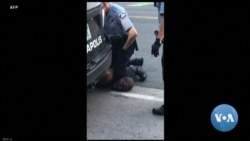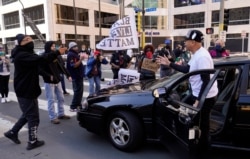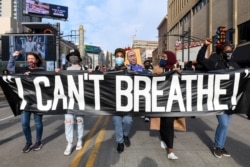The U.S. jury in the high-profile trial of a white former police officer accused in the death of George Floyd watched the video of the 46-year-old Black man gasping for breath, as the trial opened Monday.
The widely seen video of Floyd dying while in police custody last year in Minneapolis, Minnesota, triggered protests around the world against police abuse of minorities.
Jurors watched as former Minneapolis police officer Derek Chauvin pinned Floyd to the pavement for more than nine minutes, while Floyd repeatedly said that he couldn’t breathe. Onlookers in the video repeatedly shout at Chauvin to get off Floyd.
Both the prosecution and defense gave opening arguments at the start of the trial Monday, offering sharply different views of how Floyd died while in police custody.
State prosecutor Jerry Blackwell accused Chauvin, on trial for murder, of using “excessive and unreasonable” force when he pinned his knee on Floyd’s neck on a city street after a nearby shopkeeper accused Floyd of trying to use a counterfeit $20 bill to buy cigarettes.
Blackwell told the 12-member jury in opening arguments in the Minneapolis trial that the veteran police officer “betrayed his badge” in the incident.
“He was defenseless,” Blackwell said of Floyd. “He wasn’t resistant.”
But defense attorney Eric Nelson countered in his opening argument, “Derek Chauvin did exactly what he had been trained to do in his 19-year career” — to restrain Floyd after he had resisted arrest.
Nelson said medical evidence in the case will show there were “none of the tell-tale signs of asphyxiation” that the prosecution claims killed Floyd from Chauvin pressing against his neck.
Rather, Nelson contended, Floyd died from underlying health issues, including high blood pressure and drug use.
The 45-year-old Chauvin has pleaded not guilty to second-degree murder, third-degree murder and second-degree manslaughter charges in the death of Floyd. If convicted, he could face several years in prison.
Chauvin says he was following police training in arresting Floyd as he pinned him to a city street by keeping his knee on Floyd’s neck for what his supporters said was for 8 minutes and 46 seconds. Blackwell said Monday that a further review of the video showed Floyd was pinned for 9 minutes and 29 seconds.
Following opening arguments, a Minneapolis police dispatcher, Jena Scurry, testified that she watched part of Floyd’s arrest through a city surveillance camera and was so disturbed that she called a supervisor.
A bystander to the incident, Donald Williams, testified that Chauvin appeared to increase the pressure on Floyd's neck several times. Williams, who said he was trained in mixed martial arts, said he yelled to the officer that he was cutting off Floyd’s blood supply.
At the White House Monday, press secretary Jen Psaki told reporters that President Joe Biden will be watching the trial “closely.”
Before the trial started, Floyd family attorney Benjamin Crump and other supporters knelt on a sidewalk outside the courthouse to simulate the distress Floyd was facing last May 25.
“What kind of hate would you have to keep pressure on for that length of time?” civil rights activist Reverend Al Sharpton said. “It became deliberate and intentional.”
Crump said, “America, this is the moment to show the rest of the world … there is liberty and justice for all.”
In a victory for the defense, the judge overseeing the trial said Nelson could tell the jury about a 2019 encounter between Floyd and Minneapolis police during which Floyd allegedly exhibited behavior similar to his actions in the incident in which he died.
Nelson has said the 2019 incident is central to his argument that Floyd’s health issues and the level of drugs in his system killed him, not Chauvin pinning him down on May 25, 2020.
Prosecutors opposed admission of a two-minute video of the 2019 incident, contending that it was an attempt to tarnish Floyd’s character in the minds of the jurors.
Street protests of police treatment of minorities, some of which turned violent, erupted in numerous U.S. cities and elsewhere throughout the world in the weeks after Floyd’s death.
Over the last three weeks, the jury was picked to try the case. The panel, along with two alternates, is racially diverse.
It includes six white women, two white men, three Black men, one Black woman and two multiracial women, according to court records.
The city of Minneapolis agreed recently to pay Floyd’s relatives $27 million in damages to settle their claims of abuse in the case. But the trial was not delayed because of the settlement.
Steve Herman contributed to this report.












